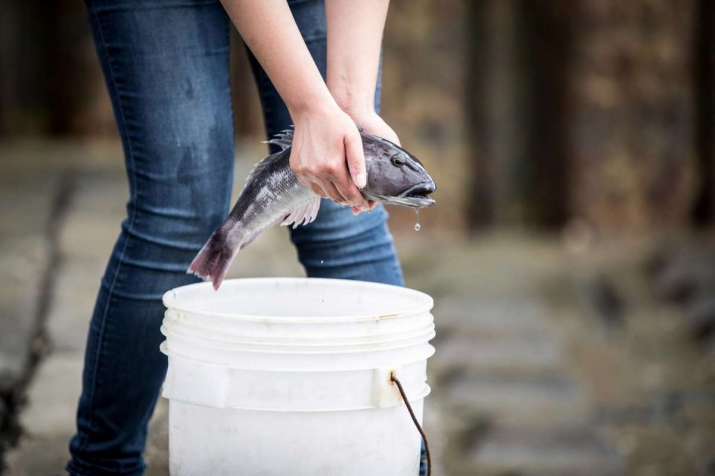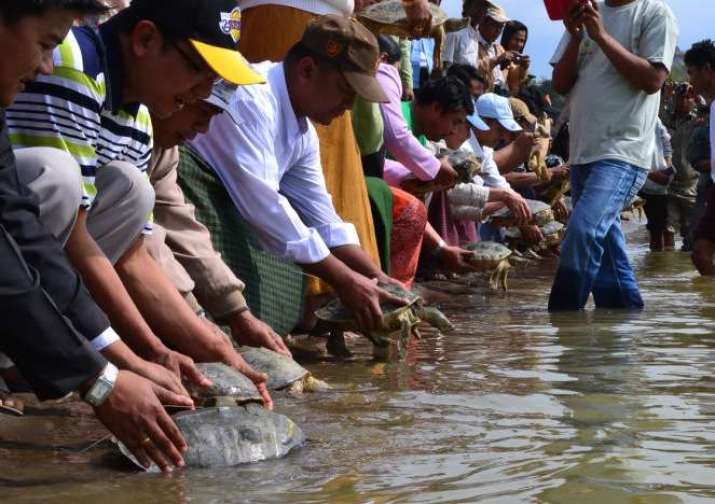NEWS
Environmental Expert Warns that Buddhist Practice of Life Release Could Spark Ecological Crisis
 From nzherald.co.nz
From nzherald.co.nzUpdated with a statement from the Fo Guang Shan Buddhist temple.
An environmental expert in New Zealand has cautioned Buddhists against practicing life release—the act of saving the life of an animal by returning it to the wild—warning that unmindfully releasing animals into environments to which they are not native can be deadly for the animals being freed and in some cases can wreak havoc on delicate ecosystems.
“While well intentioned, releasing captive animals into the wild is often not in the released animals’ best interest and it can also harm our natural environment,” said Dr. Imogen Bassett, biosecurity principal advisor for Auckland Council. “Released animals may not be able to find sufficient food, shelter, or adapt to the environment around them, leading to animal welfare problems.” (New Zealand Herald)
Life release is practiced by Buddhist monastics and lay followers alike in almost all schools of Buddhism. It is commonly viewed as an ideal way to earn spiritual merit and, through a small act of compassion, to make the world just a little bit better. However, as with many good intentions, when not practiced mindfully and with skill, it can result in more harm than good.
The practice traditionally involves freeing animals that would otherwise have been killed—such as fish bought from a fisherman or a seafood restaurant, or farm animals from a slaughterhouse. Yet amid the growing popularity of life release in Buddhist communities around the world, it has become increasingly recognized that there are many unanticipated and potentially negative consequences, both for the animals being released and for the environments they are entering.
 From asiaone.com
From asiaone.comBasset noted that New Zealand’s ecosystems are particularly vulnerable to the introduction of non-native species. “Animals such as turtles or koi carp that are not native to New Zealand can have a devastating impact on our native species and put an additional stress on our already fragile freshwater ecosystems.” she said. (New Zealand Herald)
Some of the problematic aspects of life release include releasing animals into environments in which they are unsuited to survive, the introduction of invasive species into non-native environments, where they may have no natural predators or where they may introduce diseases, resulting in the loss of biodiversity, as well as the increasingly common practice of capturing or breeding animals explicitly for the purpose of release—usually in exchange for money—resulting in a self-perpetuating and self-defeating cycle of suffering for the animals being “freed.”
By way of example, Basset observed that the red-eared slider turtle, originally native to the southern United States and northern Mexico, is one of the world's 100 worst invasive species, and can destabilize vulnerable ecosystems when introduced. As a rrsult of its popularity as a pet, the red-eared slider turtle has become established in many areas around the world, where it often outcompetes native species
One unidentified Buddhist practitioner interviewed by the New Zealand Herald newspaper explained that she preferred to buy turtles for life release because they symbolize long life in Chinese cosmology and would earn her greater merit. She said she purchased pet turtles online for between NZ$40 and NZ$100 (US$27–US$67) each.
Life release in Thailand
Buddhists interviewed by the newspaper said they had been releasing eels and fish bought from restaurants and markets into rivers and the sea.
As the practice gains popularity and social acceptance, life release has evolved from an occasional event into a regular activity at many Buddhist temples and communities around the world, not only to make merit, but also as a way of raising funds. In many instances, what was once a spontaneous act of compassion now involves highly choreographed formal ceremonies with hundreds of animals.
New Zealand’s Department of Conservation has also advised against the practice, cautioning that the release of any animals can have unintended repercussions on existing wildlife populations. Instead of life release, the country’s authorities have urged concerned animal lovers to join conservation groups and projects that run programs that actively protect native species—such as captive rearing and reintroduction initiatives.
University of Auckland senior medical lecturer Tony Fernando, himself a devout Buddhist, suggested that there are other, possibly better ways than life release for compassionate Buddhists to make merit.
“The freeing of animals is a noble tradition of compassion in action,” he noted. “But a more practical but definitely more difficult practice is to practice kindness in speech, thought, and action consciously, on a daily basis—not just to animals, but also to family, colleagues, friends, and strangers.” (New Zealand Herald)
 From myanmar.wcs.org
From myanmar.wcs.orgIn response to the New Zealand Herald report, the Fo Guang Shan Buddhist temple in South Aukland issued a statement clarifying that acts of releasing animals were not something propagated at the temple and urging members of society to apply wisdom when desiring to act on compassion. The statement included a quote on the subject from Fo Guang Shan Buddhist Order founder Venerable Master Hsing Yun:
“Compassion and tolerance alone are not enough. They need to be supplemented by wisdom. In this world, the meaning of compassion is often distorted, leading to excessive indulgence and turning a blind eye to what is wrong. When applied inappropriately, compassion can become the source of crimes and wrongdoings. For instance, the common practice of freeing live animals actually causes harm to more animal lives. Inappropriate and lavish giving of money only nurture greed and corruption. Therefore, true compassion and tolerance must be supplemented by prajna wisdom to prevent traveling down the wrong path, rendering the initial intentions futile.”
See more
Buddhist animal release practice: Saving lives or contributing to an ecological disaster? (New Zealand Herald)
Buddhist animal welfare practice could spark ecological disaster (Newstalk ZB)
Related news from Buddhistdoor Global
Singapore Buddhist Federation Promotes Alternatives to Life Release for Vesak Celebrations
Buddhist Monk Highlights Need for Conservation on the Tibetan Plateau
The Ugly Face of Life Release
Ecologists Criticize Hong Kong Buddhists for Releasing Horseshoe Crabs to their Death
Related features from Buddhistdoor Global
Buddhistdoor View: Mitigating and Managing Local and Global Ecological Crises
Rethinking Life Release














